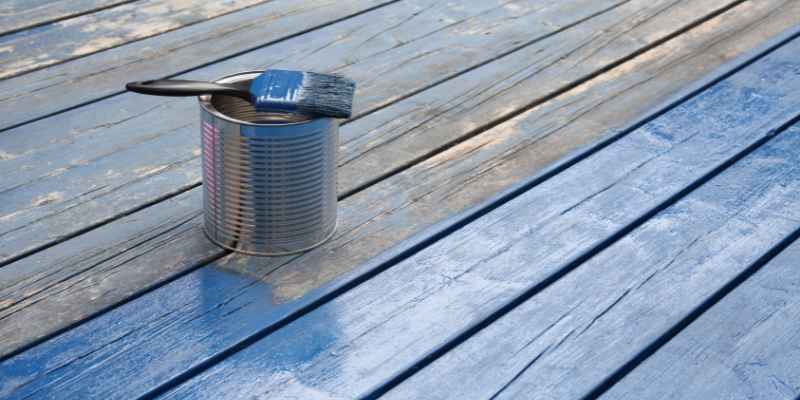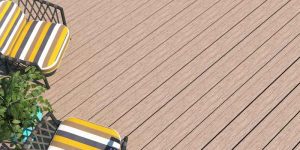Yes, composite wood can be painted, but it is crucial to use exterior latex acrylic paint specifically designed to withstand harsh weather conditions. Newer generation composite decking with a PVC cap or shell is low maintenance but prevents paint and stain adhesion.
To paint composite wood, the surface should be roughened by light sanding, then cleaned with a power wash. Next, prime with an oil-based primer and finish with two coats of premium paint. However, if the composite material has a polymer capping, it might not be suitable for painting.
It’s essential to understand the specific type of composite wood and its composition before attempting to paint it.
Introduction To Painting Composite Wood
Composite wood, made from a combination of wood fibers and plastic, has gained significant popularity in recent years due to its durability and low maintenance. However, many homeowners wonder if composite wood can be painted to change its appearance or to match their outdoor decor. In this article, we will explore the process of painting composite wood and discuss its benefits and importance. So let’s dive right in!
Understanding Composite Wood
Before delving into the process of painting composite wood, it’s crucial to understand what composite wood actually is. Composite wood is a type of material that combines recycled wood fibers and plastic to create a strong and long-lasting alternative to traditional wood. This material is resistant to rot, decay, and insect damage, making it an ideal choice for outdoor structures like decks, fences, and pergolas.
Importance Of Painting
While composite wood is durable and low maintenance, painting it can provide several benefits. One of the key reasons homeowners choose to paint composite wood is to enhance its aesthetic appeal. Painting allows you to personalize your outdoor structures and match them to your home’s exterior or your preferred color scheme.
Additionally, painting composite wood can offer an added layer of protection against the elements. Exterior paint is designed to resist fading, cracking, and peeling, keeping your composite wood structures looking vibrant and beautiful for years to come.
Benefits Of Painting Composite Wood
Painting composite wood offers numerous benefits that go beyond aesthetics. Some of the key advantages of painting composite wood include:
- Enhanced Durability: Exterior paint acts as a protective barrier, shielding the composite wood from moisture, UV rays, and other environmental factors that can cause damage.
- Increased Lifespan: By painting composite wood, you can extend its lifespan by protecting it from wear and tear.
- Easier Maintenance: Painted composite wood requires less maintenance compared to unpainted surfaces. It is easier to clean and repel dust, dirt, and stains.
- Improved Resistance: Exterior paint can make the composite wood more resistant to scratches, scuffs, and marks.
In conclusion, painting composite wood is not only possible but also beneficial. It allows you to customize your outdoor structures while providing additional protection and durability. Stay tuned to discover the step-by-step process of painting composite wood in our upcoming articles!
Choosing The Right Paint For Composite Wood
When it comes to painting composite wood, selecting the right type of paint is crucial for achieving the desired results and ensuring longevity. Understanding the different types of paint suitable for composite wood and the considerations for exterior paint can greatly impact the overall outcome of the painting project. Moreover, exploring the advantages of using latex acrylic paint for composite wood helps in making an informed decision. Let’s delve into the various aspects of choosing the right paint for composite wood.
Types Of Paint For Composite Wood
When painting composite wood, it is essential to opt for a high-quality paint that is suitable for exterior use. There are primarily two types of paint commonly used for composite wood: oil-based paint and latex acrylic paint. While oil-based paint provides excellent adhesion and durability, latex acrylic paint offers flexibility and ease of application, making it an ideal choice for composite wood. Understanding the differences between these two types of paint helps in making an informed decision when it comes to painting composite wood.
Considerations For Exterior Paint
Choosing the appropriate exterior paint for composite wood involves considering various factors such as weather resistance, UV protection, and overall durability. It is crucial to select a paint that can withstand harsh weather conditions and maintain its color and finish over time. Additionally, the paint should adhere effectively to the composite wood surface, ensuring long-lasting performance. Considering these aspects when choosing exterior paint for composite wood helps in achieving a high-quality and durable finish.
Advantages Of Latex Acrylic Paint
Latex acrylic paint offers numerous advantages when it comes to painting composite wood. Its water-based formulation provides quick drying, minimal odor, and easy cleanup, making it a convenient choice for DIY enthusiasts. Additionally, latex acrylic paint exhibits excellent adhesion to composite wood surfaces, ensuring a long-lasting and vibrant finish. Its flexibility and resistance to cracking or peeling make it an ideal option for outdoor applications, providing enhanced durability and weather resistance. Choosing latex acrylic paint for painting composite wood offers a multitude of benefits, contributing to a successful and visually appealing result.
Preparing Composite Wood For Painting
Cleaning The Surface
Begin by cleaning the composite wood surface thoroughly to remove any dirt, debris, or residue that may hinder paint adhesion.
Sanding The Wood
Next, lightly sand the composite wood to create a rough surface that allows the primer and paint to adhere effectively.
Priming The Wood
Apply a high-quality primer to the sanded composite wood to ensure a strong bond between the surface and the paint, promoting long-lasting results.
Painting Techniques For Composite Wood

Using A Brush
When painting composite wood using a brush, ensure you choose a high-quality synthetic bristle brush for smooth application.
Using a roller
Using A Roller
Opt for a short nap roller when painting composite wood to achieve even coverage and reduce streaking.
Spray painting
Spray Painting
Consider spray painting for larger surface areas of composite wood to achieve a faster and more uniform finish.
Tips For A Successful Composite Wood Painting Project
In order to ensure a successful composite wood painting project, there are some important tips to consider. By implementing the following strategies, you can achieve a professional and long-lasting finish on your composite wood surfaces.
Working In Small Sections
When painting composite wood, it’s essential to work in small sections to ensure an even application and consistent coverage. By dividing the surface into manageable areas, paint can be applied more precisely, minimizing the risk of missed spots or uneven coating. This method also allows for better control over brush strokes, resulting in a smoother and more polished finish.
Allowing Proper Drying Time
One of the most critical aspects of painting composite wood is allowing for adequate drying time between coats. Each layer of paint should be given sufficient time to dry and cure before applying additional coats. This not only ensures optimal adhesion and durability but also prevents bubbling or peeling of the paint. Following the manufacturer’s recommended drying times is crucial for a successful painting project.
Applying Multiple Coats
Applying multiple coats of paint to composite wood is essential for achieving a vibrant, long-lasting finish. Each layer builds upon the previous one, enhancing color and providing added protection against wear and external elements. By applying uniform coats and allowing proper drying time between each application, you can ensure a durable and aesthetically pleasing result.
Common Mistakes To Avoid When Painting Composite Wood
When painting composite wood, avoid skipping surface preparation and using the wrong type of paint. Ensure to sand, clean, prime with oil-based primer, and apply premium paint in two coats for a durable finish. Choose exterior paint suitable for outdoor conditions to prevent premature peeling and fading.
Skipping Surface Preparation
One of the most common mistakes when painting composite wood is skipping surface preparation. Properly preparing the surface ensures better paint adhesion and longevity of your paint job. Before painting, make sure to clean the composite wood thoroughly to remove any dirt, dust, or debris. You can use a mild detergent mixed with water and a soft brush to gently scrub the surface. Once clean, rinse the surface with clean water and allow it to dry completely.
Using The Wrong Type Of Paint
Using the wrong type of paint is another mistake to avoid when painting composite wood. It is important to choose a paint that is specifically formulated for exterior use and can withstand harsh weather conditions. Latex acrylic paint is recommended for its durability and ability to adhere well to composite wood surfaces. This type of paint is also available in a wide range of colors, allowing you to achieve the desired look for your composite wood.
Applying Too Much Paint
Applying too much paint is a common mistake that can lead to a poor finish and premature peeling or cracking. When painting composite wood, it is important to apply thin, even coats of paint. Start with a small amount of paint on your brush or roller and spread it evenly across the surface. Avoid overloading the brush or roller with paint, as this can result in thick and uneven coverage.
Maintaining And Caring For Painted Composite Wood
Composite wood is a popular choice for outdoor decking and furniture due to its durability and low maintenance. However, if you want to add a personal touch or update the look of your composite wood, you may wonder if it can be painted. The good news is that yes, composite wood can be painted, but it requires proper care and maintenance to ensure the longevity and appearance of the paint finish. In this article, we will guide you on how to maintain and care for painted composite wood so that your investment stays beautiful and protected for years to come.
Regular Cleaning
Regular cleaning of painted composite wood is the key to maintaining its appearance. Outdoor elements like dirt, dust, and pollen can accumulate on the surface, making it look dull and dirty. To clean painted composite wood, follow these steps:
- Start by removing any loose dirt or debris using a soft-bristle brush or broom. This will prevent scratches during the cleaning process.
- Next, prepare a solution of mild soap or detergent and water.
- Dip a soft cloth or sponge into the soapy water and gently scrub the painted surface. Avoid using abrasive cleaners or scrub brushes, as they can damage the paint.
- Rinse the surface thoroughly with clean water to remove any soap residue.
- Allow the painted composite wood to air dry completely before using or applying any additional maintenance products.
Avoiding Abrasive Cleaners
While cleaning painted composite wood, it is essential to avoid using abrasive cleaners. These can scratch the paint and diminish its appearance over time. Instead, opt for mild soap or detergent solutions to remove dirt and stains. Additionally, avoid using scrub brushes with hard bristles, as they can also cause damage. By using gentle cleaning methods, you can preserve the beauty and integrity of the painted surface.
Touching Up Paint As Needed
Over time, painted composite wood may experience wear and tear, such as scratches or chips in the paint. To ensure that your composite wood maintains a seamless and uniform appearance, it’s essential to touch up the paint as needed. Follow these steps to touch up the paint:
- Clean the area around the damaged paint with mild soap and water, removing any dirt or debris.
- Use fine-grit sandpaper to smooth out any rough edges and create a smooth surface for the touch-up paint.
- Apply an appropriate outdoor paint that matches the color of the existing paint. Be sure to choose a paint designed for use on composite wood and follow the manufacturer’s instructions for application.
- Allow the touch-up paint to dry completely before using the composite wood.
By regularly cleaning painted composite wood, avoiding abrasive cleaners, and touching up the paint as needed, you can maintain the beauty and longevity of your investment. Remember to always follow the manufacturer’s instructions for cleaning and maintenance to ensure the best results. With proper care, your painted composite wood will continue to impress and enhance your outdoor space for years to come.

Frequently Asked Questions On Can Composite Wood Be Painted
What Kind Of Paint Do You Use On Composite Wood?
You should use latex acrylic paint on composite wood, as it’s best suited for this type of material. It’s essential to ensure that the exterior paint is designed to withstand harsh weather conditions. Additionally, newer versions of composite decking with a PVC cap or shell may not be paintable.
Can Composite Wood Be Painted Or Stained?
Yes, composite wood can be painted or stained, but only if it is early generation composite material. Newer versions of composite decking have a PVC cap that prevents paint and stain from adhering.
How Do You Paint Over Composite?
Yes, composite wood can be painted. First, lightly sand the surface to roughen it. Then, clean off any dust and dirt by powerwashing the area. Next, apply an oil-based primer and let it dry. Finally, paint the composite wood with two coats of premium paint.
Do You Have To Prime Composite Before Painting?
Yes, when painting composite wood, it’s important to prime it first to ensure better adhesion and durability. Ensure to use a high-quality primer designed for exterior use to prevent weather damage.
Conclusion
Conclusively, painting composite wood is possible, especially early generation materials. However, the process should be approached with caution, ensuring proper preparation, use of appropriate primer, and high-quality exterior paints to withstand harsh weather conditions. Understanding the limitations of newer materials with protective caps can help in making informed decisions on painting and staining composite wood surfaces for lasting results.


